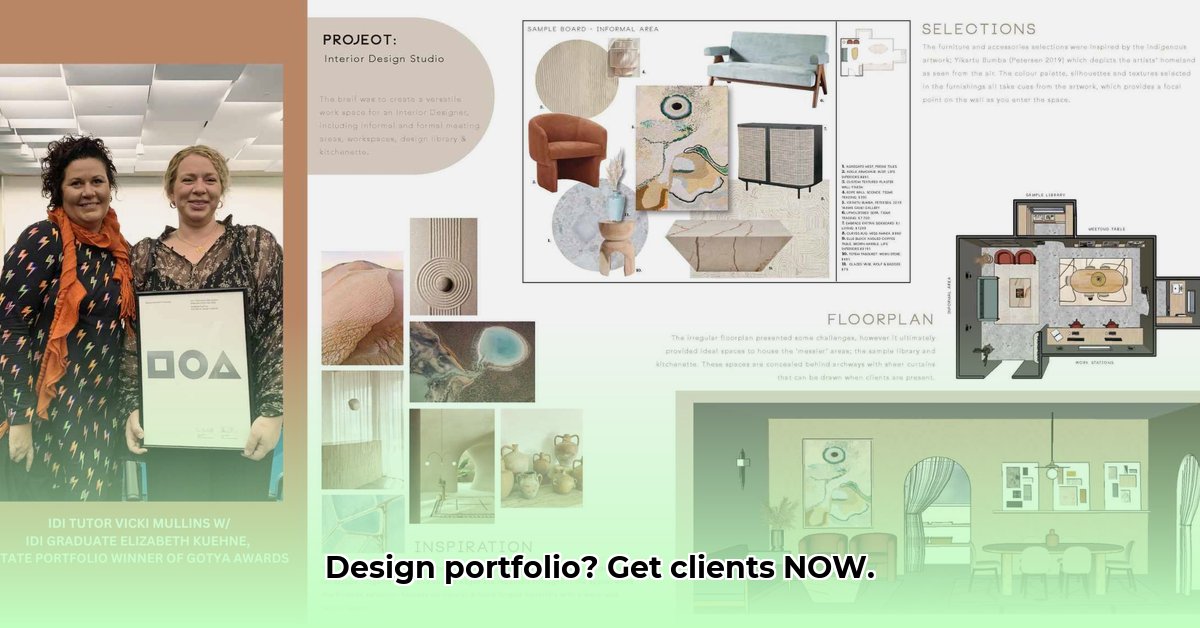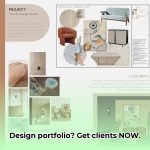Do you want an interior design portfolio that gets you clients? This guide provides actionable steps to build a portfolio that attracts clients. We’ll cover how to showcase your best work, make your online presence shine, and choose the perfect photos. It’s designed to help students, freelancers, and employed designers attract the desired projects. For small space inspiration, check out this modern small house design.
Crafting a Winning Interior Design Portfolio for Client Acquisition
Crafting an effective interior design portfolio is about more than just visuals; it’s a powerful tool to showcase your personality, skills, and attract dream clients. Your portfolio creates a strong first impression that significantly impacts your success. Let’s learn how to build a truly effective one. Remember that satisfied clients willing to provide testimonials can boost your credibility substantially.
High-Impact Visuals: Essential for Client Attraction
Your portfolio’s photos are key. Professional-quality images are essential because poor lighting instantly diminishes the appeal of even the most stunning design. Investing in professional photography isn’t just an expense; it’s an investment in your brand and business. Consider including impactful before & after shots to dramatically showcase the transformation you create.
Strategic Storytelling to Showcase Your Design Process
Instead of only presenting the finished product, take potential clients on a journey through your design process. Consider including preliminary sketches, inspiration mood boards, fabric swatches, and material samples. All this adds depth and personality to your portfolio, illustrating not only your skills but also your creative thought processes. Write a compelling but concise description for each project, focusing on the initial client needs and how your design met those objectives.
Know Your Audience to Attract Ideal Clients
Before designing your portfolio, ask yourself: Who are you trying to reach? Consider whether you are aiming for high-end residential clients, commercial developers, boutique hotels, or a blend of diverse clientele. Understanding your target audience will shape every aspect of your portfolio, from the style of your displayed projects to the tone of your accompanying descriptions. Are you a freelancer, working in-house, or a student building your initial client base?
Showcase Your Unique Style & Design Signature
What’s your unique design voice? What elements set you apart from other designers? Ensure your portfolio reflects your signature style. It’s a reflection of your artistic personality, your design philosophy, and your encompassing brand. It should accurately portray the type of work you want to attract and the design problems you expertly solve.
Navigating the Digital and Print Landscape
A professional website is crucial in today’s digital world, offering unparalleled accessibility and reach. Ensure your website features easy navigation, fast loading times, and a well-organized portfolio that’s simple to browse on any device. However, don’t dismiss the enduring power of a carefully curated printed portfolio, valuable for face-to-face meetings, client presentations, or leaving a tangible impression.
Building Your Interior Design Portfolio: A Step-by-Step Approach
Here’s a simple, effective approach to creating a standout portfolio:
- Curate Your Best Work: Select your 5-10 strongest projects, highlighting diverse skills and styles.
- High-Quality Images: Invest in professional photography to showcase your work in its best light.
- Craft Compelling Narratives: For each project, write a short, engaging description highlighting design challenges and your innovative solutions.
- Consistent Branding: Maintain a unified visual identity across your portfolio for a professional and cohesive look.
- User-Friendly Design: Whether online or offline, make sure your portfolio is easily accessible and navigable for potential clients.
- Tailor to Your Audience: Adjust the content and visual style to resonate with your target client base, emphasizing projects that align with their interests.
- Regular Updates: Keep your portfolio current and vibrant by adding your latest projects, showcasing your evolving skills and fresh design perspectives.
Long-Term Strategies: Maintaining Your Interior Design Portfolio
Your portfolio isn’t a static document; it’s a living, breathing testament to your skills. Here are strategies for sustained, long-term success:
- Continuous Improvement: Regularly review your portfolio’s effectiveness and make necessary improvements based on client feedback and industry trends.
- Brand Refinement: As your skills and experience evolve, so should your brand’s messaging, visual style, and overall presentation.
- Strategic Networking: Actively attend industry events, connect with fellow designers, and nurture relationships with current and prospective clients.
- Stay Technically Updated: Stay abreast of the latest design trends, emerging technologies, and essential software to maintain a competitive edge.
Your interior design portfolio is a dynamic and evolving tool. Consistent effort and a meticulous eye for detail are key to creating a portfolio that showcases your past successes while attracting exciting new opportunities and establishing you as a leader in your design niche.
Optimizing Your Interior Design Portfolio for SEO and Client Acquisition
Ready to attract more clients? Your interior design portfolio is your online storefront; let’s make it shine! Optimizing your interior design portfolio for SEO and client acquisition requires a strategic blend of aesthetics and online visibility. Optimizing images can increase website traffic significantly.
Step 1: Where Visual Perfection Meets Search Engine Optimization
Stunning visuals are vital, but beautiful images alone won’t attract clients organically. Search engines need to understand them contextually.
- High-Quality Images: Invest in professional-grade photography to capture the detail and beauty of your designs.
- Optimized Images: Use descriptive, keyword-rich file names (e.g., “modern-kitchen-design-NYC.jpg”). This helps search engines understand the image content.
- Alt Text Magic: Each image needs compelling, contextually relevant alt text. Describe the project’s style, key features, and location.
Step 2: Optimizing Your Website: Your Digital Showroom
Your website is your virtual design showroom. Make it equally user-friendly and search engine-friendly to ensure clients easily discover your work.
- Mobile-First Design: Does your portfolio look amazing and function seamlessly on smartphones and tablets?
- Fast Loading Times: A slow-loading website results in lost client opportunities. Optimize images and website code for quick performance.
- Clear, Intuitive Navigation: Easy-to-use navigation keeps visitors engaged, encouraging them to explore your portfolio.
- Strategic Keyword Integration: Sprinkle relevant keywords naturally throughout your website copy, project descriptions, and image alt text.
Step 3: Power of Content Marketing and Thought Leadership
Your portfolio isn’t just about showcasing visuals; it’s also about telling your story and demonstrating your expertise to potential clients.
- Detailed Project Descriptions: Provide in-depth detail for each showcased project, including the client’s needs, design challenges, and innovative solutions you implemented.
- Informative Blog Posts: Share your unique insights and expertise through regular blog posts on design trends, tips, and relevant industry topics.
- Authentic Client Testimonials: Prominently display authentic testimonials from satisfied clients to build trust and credibility in your skills.
Step 4: Enhancing your Core SEO Strategy
Robust search engine optimization is vital for ensuring your portfolio is easily discoverable by potential clients actively searching for interior design expertise.
- Comprehensive Keyword Research: Identify relevant keywords related to your design niche, services, and geographic location.
- Strategic Local SEO: Cater to your local market and optimize your Google My Business profile to rank higher in local search results.
- Earning Quality Backlinks: Actively work on acquiring backlinks from reputable websites and design publications to boost domain authority.
Actionable Takeaways:
- High-quality resolution images are crucial, and optimizing alt text is critical for enhanced SEO and accessibility.
- Mobile responsiveness and fast loading speeds are essential for user experience and improved search ranking.
- Strategic keyword integration improves search engine visibility, helping clients find your portfolio when they search for design services.
- Content marketing humanizes your brand and builds trust, establishing you as a design authority in your field.
- Local SEO is vital for attracting local clients actively searching for interior design services in their area.
- Backlinks from reputable sources boost your website’s authority and rankings.
High-Quality Photography for Interior Design Portfolios: Essential Tips and Techniques
Want to attract more clients and showcase your design talent effectively showcasing your projects? Let’s explore high-quality photography for interior design portfolios, focusing on how to make your portfolio stand out. Your portfolio is often the first impression you make with potential clients, and visual quality is a primary factor in their decision-making process.
Mastering the Art of the Shot: DIY vs. Professional
You have options: tackle photography independently or hire a professional photographer. The DIY approach can offer immediate cost savings and greater creative control. However, professional photographers bring years of experience, consistency, and polished images vital for impressing potential clients and securing lucrative projects.
Essential Tips for Stunning Interior Photography
Regardless of your chosen approach, certain time-tested techniques will elevate the overall quality and impact of your portfolio.
- Lighting is Paramount: Maximize natural light whenever possible. Open windows, use reflective surfaces to bounce light, and avoid harsh artificial lighting.
- Master Composition: Learn and strategically apply basic composition rules like the rule of thirds, leading lines, and symmetry to create visually appealing images.
- Styling and Staging: A well-styled and purposefully staged room photographs far better than a cluttered, disorganized one.
- Maintain Consistency: Maintain a cohesive visual style throughout your portfolio, including in terms of lighting, color grading, and overall aesthetic.
- Post-Processing Techniques: Learn basic photo editing techniques to correct imperfections, adjust white balance, and enhance colors.
When to Hire a Professional Photographer: Critical Decisions
Sometimes, DIY photography simply doesn’t produce the desired results. Here are several situations when investing in professional photography is an excellent investment:
- High-Stakes Design Projects: Flagship projects, luxury residences, or designs intended for publication demand the highest level of image quality that only professionals can consistently deliver.
- Strategic Client Presentations: Impress discerning potential clients with impeccably presented, visually compelling photographs that showcase your attention to detail.
- Limited Photography Skills or Equipment: If you lack expertise or professional-grade equipment, hiring a professional is key to consistent quality and upholding brand standards.
How to Build Your Dream Portfolio: An Actionable Step-by-Step Guide
- Strategically plan your photography shoots, considering the best time of day for optimal lighting conditions.
- Thoroughly declutter and professionally style your spaces to highlight key design elements and create an inviting atmosphere.
- Capture multiple shots from varied angles and perspectives to provide a comprehensive visual overview of the space.
- Edit your photos consistently using professional software to correct any imperfections and enhance overall visual appeal.
- Curate a refined selection carefully representing your design style, skill set, and target clientele.
- Regularly update your portfolio with fresh, high-quality images that showcase your latest projects and evolving design approach.
Key Takeaways:
- High-quality photography is not optional but essential for attracting new clients, securing coveted projects, and commanding premium design fees.
- DIY photography is cost-effective for smaller projects, enabling creative control and quicker turnaround times but professional photographers deliver unparalleled image quality and brand consistency.
- Mastering fundamental lighting and composition techniques is crucial for visually appealing photographs that capture the essence of your design.
- Consistency in styling and post-processing builds recognizable brand consistency that reinforces your design aesthetic and core values.
- Prioritize professional photography for high-impact, high-profile projects, client presentations, and marketing materials to make a lasting impression.
Crafting Compelling Narratives within Your Interior Design Portfolio for Client Acquisition
Crafting compelling narratives in your interior design portfolio transforms it from a mere gallery of beautiful spaces into a powerful tool for client acquisition. By weaving stories around your projects, you create an emotional connection, highlight your expertise, and demonstrate the value you bring to your clients.
Key Takeaways:
- High-quality visuals and compelling storytelling are crucial for portfolio success. This combination can significantly increase client engagement.
- Tailoring your portfolio to your target audience ensures that your narratives resonate with their specific needs and preferences.
- A strong personal brand narrative, integrated with detailed case studies, builds trust and credibility with potential clients.
- Showcasing your design process, challenges overcome, and quantifiable results enhances your narrative’s persuasive power.
- Interactive elements, such as 360° tours and videos, immerse visitors in your designs, boosting your online presence.
- Consider diverse storytelling approaches to adapt to evolving client needs and create unique and engaging experiences.
Step 1: Define Your Unique Selling Proposition (USP)
Before showcasing visuals, identify your unique style. What sets you apart from other designers? Define this essence clearly, as it’s the cornerstone of your portfolio’s narrative.
Step 2: Curate Your Best Work
Select projects that strongly showcase your USP. Don’t include every project; choose only the most captivating and representative pieces, emphasizing high-resolution photography to highlight key design elements.
Step 3: Craft Compelling Project Narratives
This is where the art truly shines. Each project description should tell a story: What were the client’s desires and challenges? What creative solutions did you implement? What were the transformative outcomes?
Step 4: Showcase Your Creative Process
Transparency builds trust with potential clients. Include sketches, mood boards, detailed material selections, or even before-and-after photos displaying the stages of the project. This offers a peek behind the curtain which clients appreciate since it demonstrates your process.
Step 5: Integrate Your Distinct Brand Story
Weave your personal design narrative into your portfolio. Share your passion for design, sources of inspiration, and overarching design philosophy. This human element makes you more relatable and memorable to potential clients.
Step 6: Quantify Your Design Success
Whenever possible, add quantifiable results to validate your skills: Increased property value, energy savings achieved, positive client satisfaction surveys, or improvements in space functionality. Numbers add weight to your narrative, demonstrating the tangible results your designs deliver.
Step 7: Optimize Your Portfolio for Enhanced Online Visibility
Your online portfolio is essentially your digital storefront. Employ SEO best practices to improve search engine visibility to attract a wider audience. Ensure your website and portfolio translate seamlessly to mobile devices. Consider incorporating interactive elements.
Step 8: Continuously Refine and Evolve Your Narrative
Design is an ever-evolving field. Regularly update your portfolio with new projects, refine existing narratives to reflect fresh insights, and adapt your portfolio to cater to changing client preferences and emerging design trends.
- Elevate Your Interior Design Portfolio: Attract Clients Now - September 1, 2025
- Discover why interior design is interesting with MintPalDecor: Transform your space now - August 29, 2025
- Discover Modern Two-Bedroom House Designs: Maximize Space & Save - August 29, 2025










